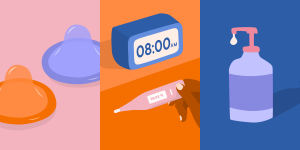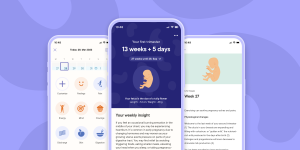Illustration by Emma Günther
Egg freezing 101
Everything you need to know about the egg freezing process: What it is, how it works, and why people choose to do it.

Top things to know about egg freezing
Egg freezing is the process of extracting eggs from the ovaries to preserve them, so they can be used to try and become pregnant at a later stage
There are many different medical, social and personal reasons why someone would choose to freeze their eggs
Egg freezing offers a chance at a live birth, but there is no guarantee
What is egg freezing?
Egg freezing, scientifically called oocyte cryopreservation, is a process in which a woman or person with ovaries’ eggs (oocytes) are extracted, frozen, and stored (1). The frozen eggs can later be thawed and used in a procedure called in vitro fertilization (IVF) in order for the individual to try and become pregnant (1).
As with all artificial reproductive technologies (ARTs), egg freezing does not offer a guarantee of a live birth, but it does offer a chance (more on this later) (2).

Why would someone freeze their eggs?
There are many different reasons why someone would consider undergoing egg freezing. Unlike embryo freezing (embryo cryopreservation), egg freezing doesn’t require sperm because the eggs aren’t fertilized before they’re frozen.
You might consider egg freezing if:
You wish to preserve eggs now for future use: There are many social and personal reasons why a person would want to delay becoming pregnant and egg freezing is a valid option for this (3,4). Freezing eggs before the age of 35 might increase the chances of a live birth in the future (2,5). While the American Society for Reproductive Medicine does not currently support elective egg freezing to delay parenthood (6), many people still choose to pursue this option for their own reasons.
You’re undergoing in vitro fertilization (IVF): IVF is a medical procedure where an egg extracted from the ovary (in the same process as egg freezing) is fertilized with sperm in a laboratory, most commonly as a treatment for conception challenges. Egg freezing may also be a choice for people who use IVF, but may have religious or ethical objections to freezing embryos (1,7,8).
You’re undergoing gender affirmation treatment: Hormonal treatments and surgical procedures can have an impact on the ability to conceive (9). Egg freezing offers the option for transmasculine individuals to preserve eggs before gender-affirming treatment (9).
You need treatment for cancer or another illness: Treatments for cancer including chemotherapy, radiation, and ovarian surgery may affect the ability to become pregnant. (5). Freezing eggs before starting treatment might offer a chance at biological children in the future (10).
You have a family history of early menopause: Some genetic conditions (e.g. Turner syndrome, Fragile X syndrome) can increase the risk of primary ovarian insufficiency (11). This is the clinical term for when the ovaries do not produce as many follicles as is typical in a person who is under 40 (12).
What does the egg freezing process entail?
Screening
The first step is a visit to an obstetrician-gynecologist (OB/GYN), or a doctor called a Reproductive Endocrinologist (REI) at a licensed fertility clinic, who will start the screening process.
They will check your ovarian reserve. This will involve blood tests and an ultrasound (13). These tests estimate the number of eggs in your ovaries that can be collected for freezing (13). Your blood will also be tested for infections like HIV and hepatitis. Testing positive for one of these infections doesn’t mean you can’t freeze your eggs, but it usually means your eggs will be stored separately to prevent transmission to other samples.
Ovarian stimulation
Once you’ve completed all the tests, your doctor will make a plan called a protocol. It is based on your age, hormones, and any conditions or medical treatments you’ve experienced or continue to experience (14). You’ll start by tracking your cycle. Once you are ready to begin the process, you will be taught how to give yourself injections of gonadotropin hormones that stimulate your ovaries to produce more eggs (14). In some cases, individuals choose to enlist the help of a partner, family member or friend.
In a typical menstrual cycle, your ovaries prepare a variety of follicles, or fluid-filled sacs containing eggs. About halfway through your follicular phase (around the time your period is ending) your body will pick a dominant follicle, mature that egg for ovulation, and the rest of the follicles will fade away. The goal of stimulating the ovaries in an egg-freezing cycle is to mature a few follicles at once to collect the eggs inside them (14).
Frequent blood tests and ultrasounds will watch how the follicles grow. You’ll likely take other medications so you don’t ovulate before the follicles are ready (14). The ovarian stimulation part of the egg freezing cycle typically takes anywhere between eight and 12 days (13).
Once the follicles have reached a certain size, you will give yourself an injection of human chorionic gonadotropin (hCG) at home. This injection is sometimes called a trigger shot and is designed to help the eggs mature (15). Depending on your protocol, you may receive a gonadotropin-releasing hormone agonist (GnRHa) trigger instead (15).
Egg retrieval
The egg retrieval procedure typically takes place at your fertility clinic while you are asleep under anesthesia or sedation (16). The most common way to retrieve the eggs is through vaginal ultrasound aspiration, when an ultrasound probe is inserted into your vagina to locate the follicles (13).
A needle is then guided through the vaginal wall and into a follicle (13). A suction device connected to the needle is used to remove the egg from the follicle (13). The number of eggs that can be collected from one cycle will depend on your age, ovarian reserve, and how you responded to the hormones (2). This means that multiple egg freezing cycles may be needed to achieve the number of eggs you are hoping for (13).
It’s worth noting that in an IVF cycle, the eggs are then fertilized with sperm, and are either placed into the uterus in hopes to create a pregnancy, or frozen for future use.
Freezing
Shortly after the egg retrieval, the collected eggs will be frozen, most commonly through a process called vitrification, which helps prevent ice crystals from forming during the freezing process (6). The frozen eggs are stored in a labeled canister that is submerged in liquid nitrogen to maintain sub-zero temperatures (6).
Post-procedure
After the egg retrieval, you may experience cramping, spotting, and feelings of fullness and/or pressure (17). These sensations usually go away in a few weeks as your ovaries return to their typical size (17).
You can usually go back to your regular routine within a week of the egg retrieval. Your healthcare provider will give you specific advice based on your situation.
Ovarian stimulation can increase the chance of pregnancy. If you intend to have sex, it’s important to use a condom or other barrier method while taking ovarian stimulating medications, and after the egg retrieval procedure, if you don't want to become pregnant.
What are the risks associated with the procedure?
Egg freezing is a common procedure that is considered a minor surgery. Serious complications associated with the medications and egg-retrieval process are rare. However, like all medical procedures, things can happen unexpectedly. These include:
Ovarian hyperstimulation syndrome (OHSS): OHSS is a complication of ovarian stimulation, which might look and feel different for different people (14). It can happen when a person produces a larger number of eggs than is typical (14). OHSS is usually mild and is treated with over-the-counter pain medication. In very rare cases, severe OHSS can be life-threatening (14). It’s important to contact your fertility clinic if you develop any symptoms of OHSS (14).
Symptoms of OHSS include (14):
-Swollen stomach and stomach pain
-Nausea and vomiting
-Difficulty breathing
-Reduced urine output
Complications from the egg retrieval procedure: These are good to be aware of so you can watch for signs. Your healthcare provider will give you specific instructions, but some potential issues could be bleeding, infection, and thrombosis (blood clots blocking veins or arteries). Being put to sleep, or under anesthesia can also come with some unexpected events. Your anesthesiology provider can tell you about these (18).
Emotional implications: Egg freezing can offer the chance of a future pregnancy, but there is no guarantee the procedure will be successful (2). Having eggs in storage might provide a false sense of security and this may encourage delaying parenthood even longer, with no guarantee of a future pregnancy (18).
Using frozen eggs to try to conceive
Once you decide to thaw your eggs and use them to try to conceive, you’ll go through the IVF process (minus the egg retrieval part), where the egg is then fertilized with your partner’s or a donor’s sperm.
Eggs that have been previously frozen are generally fertilized using a method called intracytoplasmic sperm injection (ICSI) (6). This is when a scientist who works with embryos, called an embryologist, carefully selects one sperm and injects it directly into the egg (19). If the sperm fertilizes the egg, the embryologist will grow the embryo in a petri dish (culture the embryo) until it is ready to be placed into the uterus (20).
What are the chances of live birth using frozen-thawed eggs?
The aim of freezing eggs is to increase the chances of a live birth at a later stage. So you may be wondering: how many frozen eggs are enough to actually achieve a live birth?
Unfortunately, there is no straightforward answer to this question. To date, it’s interesting to note that few women who have chosen to freeze eggs for elective reasons have actually returned to use their eggs (2). A lack of data makes it difficult to understand why this is the case and to accurately calculate success rates (2).
Some fertility clinics will tell patients to freeze at least 15-20 eggs based on age, but there is limited data to support recommendations on the ideal number of eggs to store (21,22).
Some factors that can affect the likelihood of live birth after egg freezing include:
The age at which you froze your eggs: Research tells us that errors in the genetic makeup in eggs increase with age, which can impact fertilization and implantation rates (5). As age increases, ovarian reserve decreases (5). So, a 38-year-old woman may need more rounds of egg freezing than a 28-year-old to freeze the same number of eggs. But, this is a general trend and not a one-size-fits-all scenario.
The method used to freeze the eggs: There are currently two methods to freeze eggs: Vitrification (the newer “flash freezing” technique), and the older slow-freezing technique. More eggs frozen by vitrification survive the thawing process, and there is a higher chance of a live birth compared to slow-freezing (6,23). In one study, about 9 in 10 eggs frozen using vitrification survived the thawing process, compared to 6 in 10 eggs frozen using the slow-freezing method (24).
In fact, the success of vitrification was one of the reasons that, in 2013, the American Society for Reproductive Medicine (ASRM) decided to remove the label of “experimental” for egg freezing (6).
The quality of the sperm used to fertilize the eggs: It takes both an egg and a sperm to create an embryo, so sperm quality matters, too. Testicular trauma, diet, age, genetics, certain medications, tobacco, and other substance use can affect sperm quality (25). If you are looking to conceive with your partner’s or a donor’s sperm, your fertility clinic will run tests to check the quality of the sperm, and may suggest ways to optimize it (26). Freezing sperm in advance is also something people may choose to do.
Egg freezing isn’t an insurance policy
While egg freezing may help relieve some stress about your ability to conceive in the future, it shouldn’t be thought of as an insurance policy (1). Some fertility clinics may try to lead patients to believe that egg freezing can be a way to delay parenthood, but this isn’t currently supported by the American Society for Reproductive Medicine (6). Delaying pregnancy until an advanced maternal age may increase the chances of medical complications, and there is no number of frozen eggs that will guarantee an infant in your future. (2).
Consider this: How would you feel if your egg freezing cycle resulted in no eggs? When someone makes the decision to freeze their eggs, it’s important to weigh all the possible outcomes and be emotionally prepared for the scenario where it doesn’t work out.
Getting informed in advance can help
It’s understandable to feel overwhelmed when making decisions about your reproductive health. If you're considering egg freezing, it’s important to have a full understanding of the likelihood of success, as well as the costs (financial, physical and emotional) and how the process could impact your overall wellbeing (1). Speaking to a healthcare provider now can help you get an idea of whether egg freezing might be right for you.




